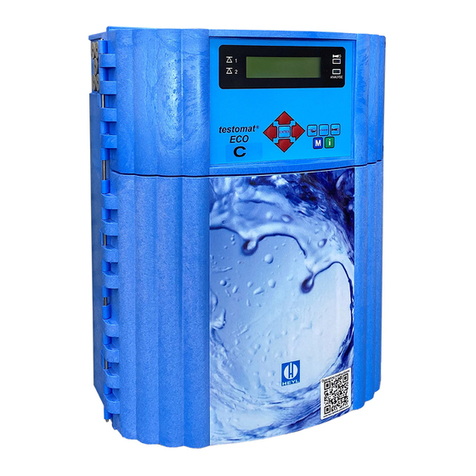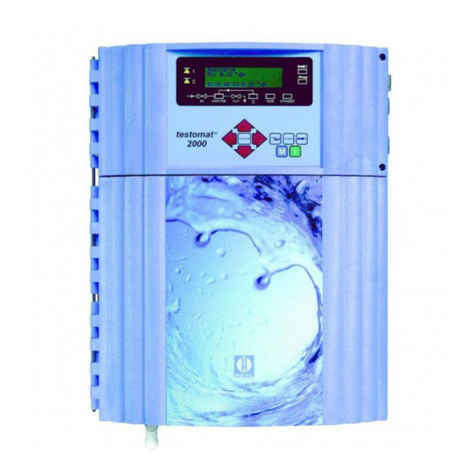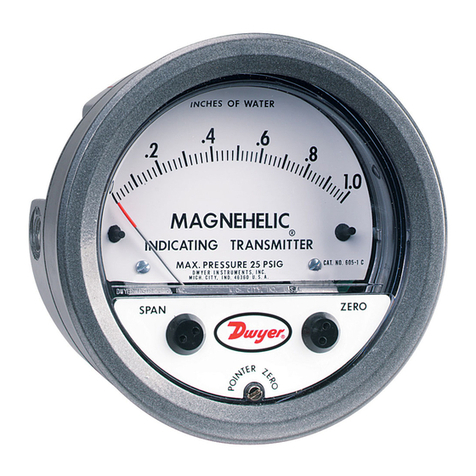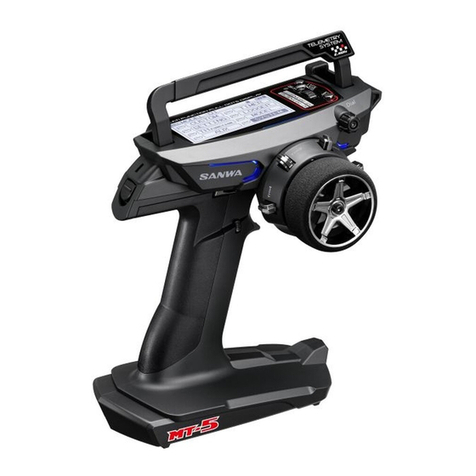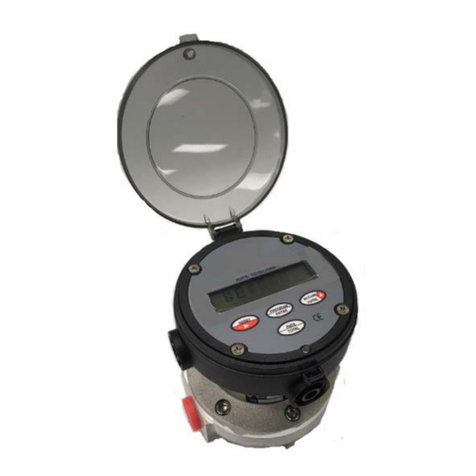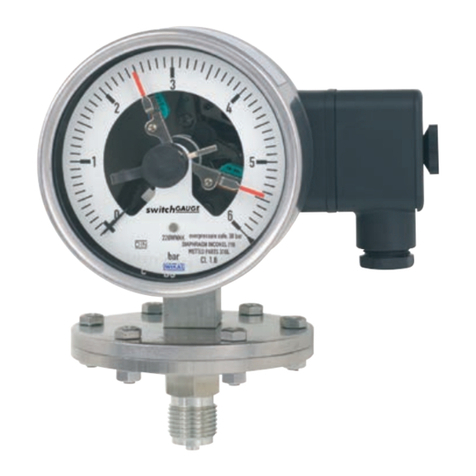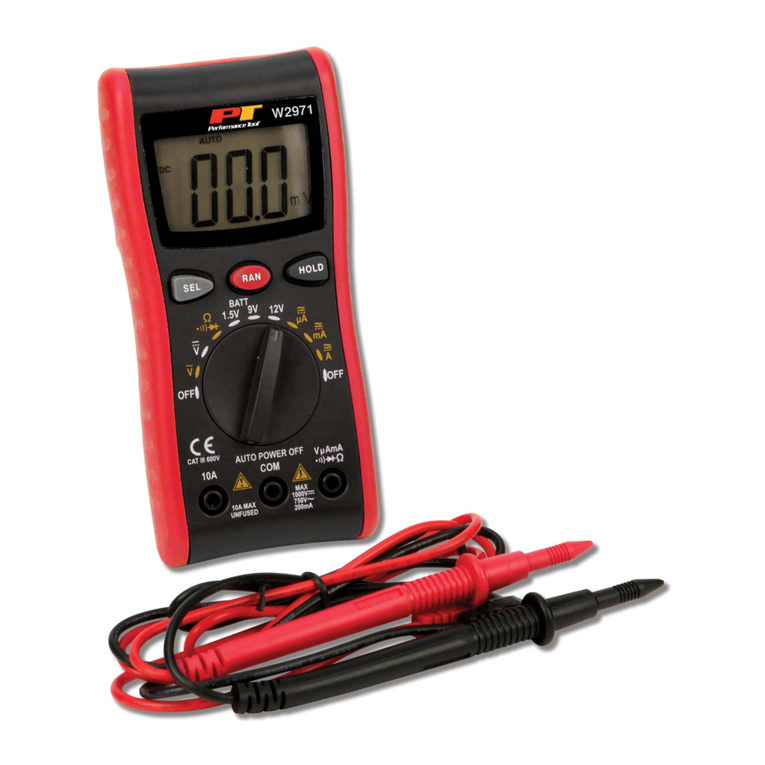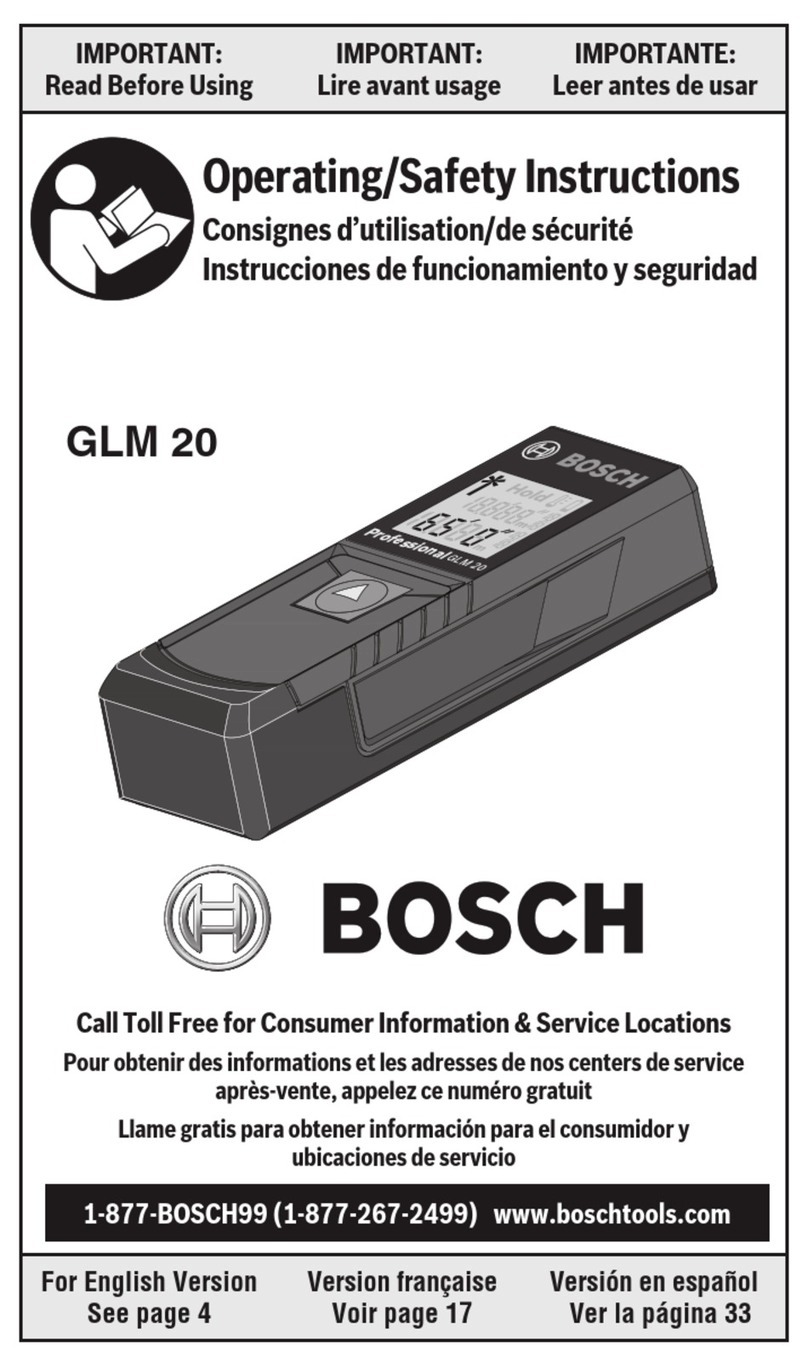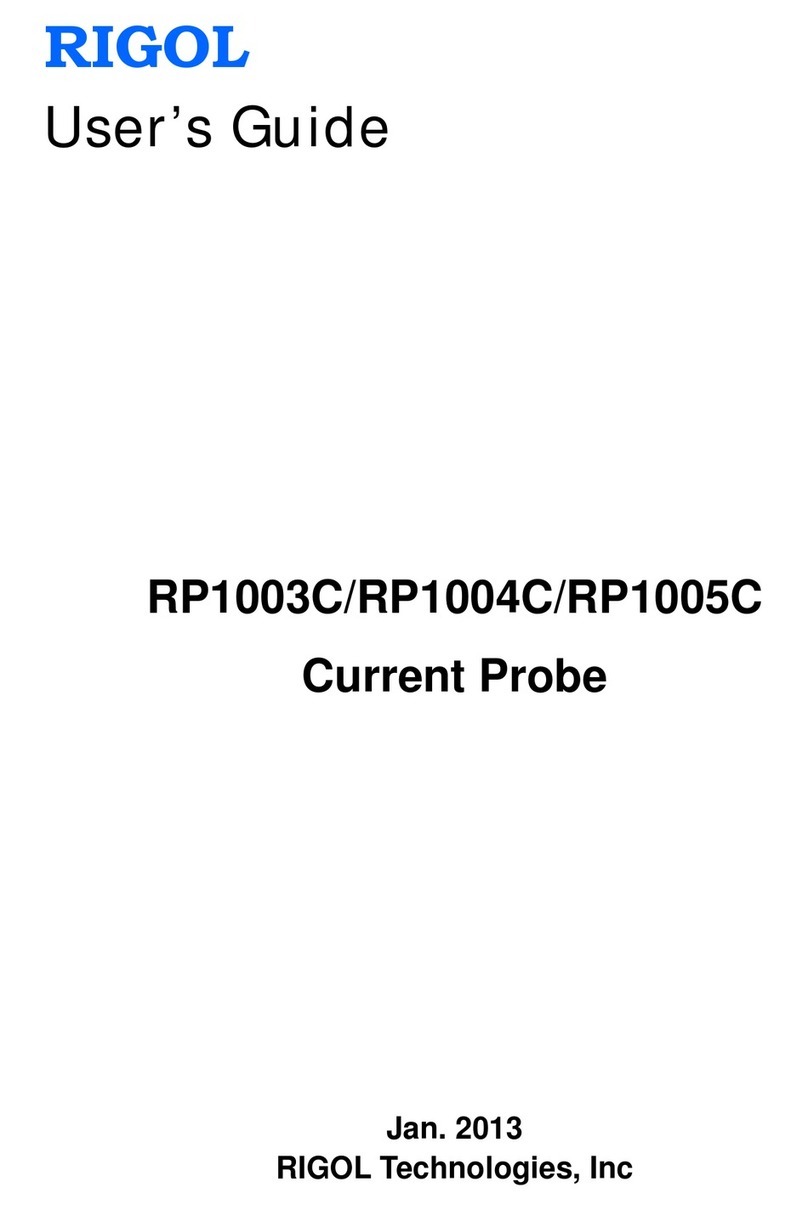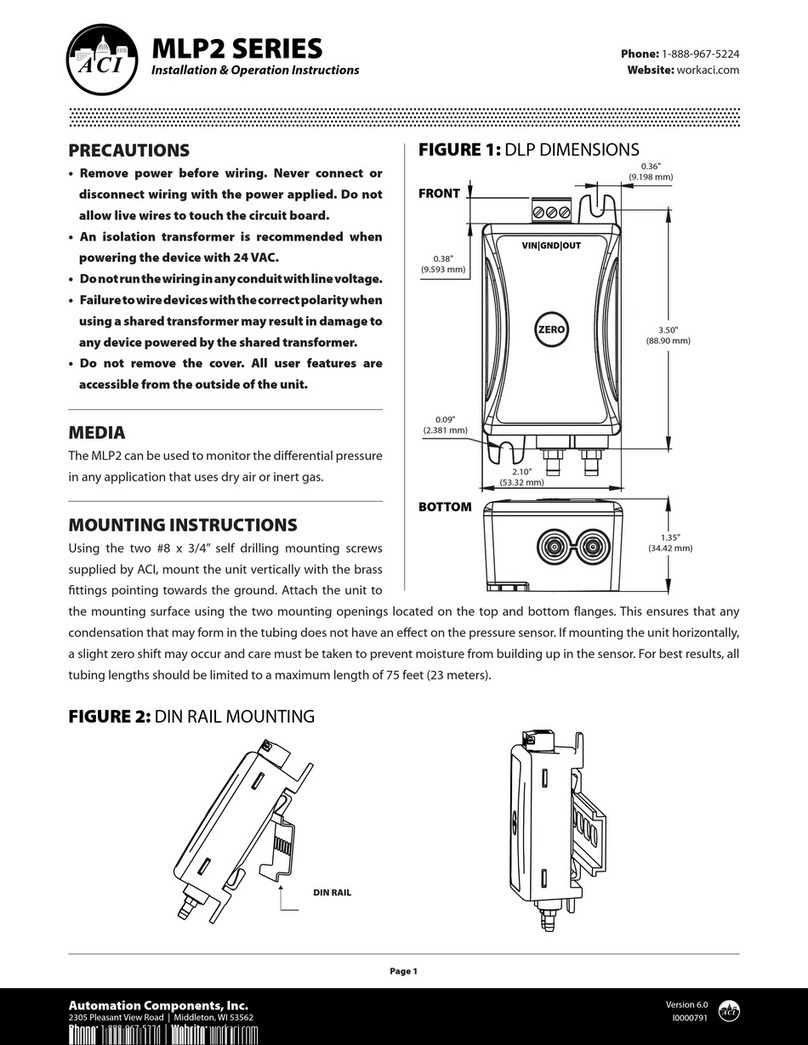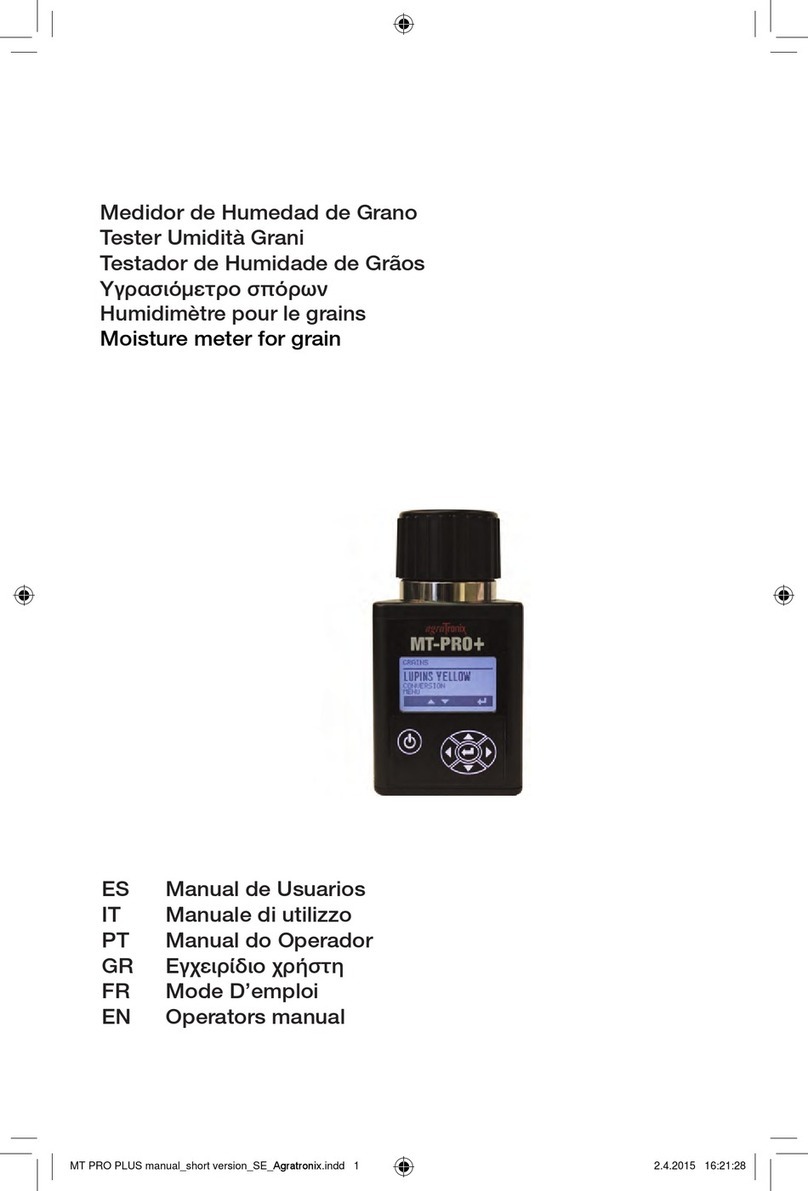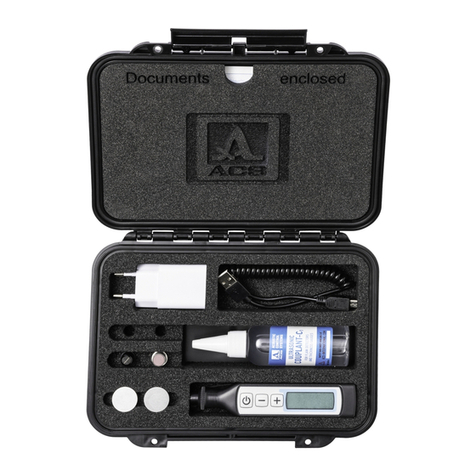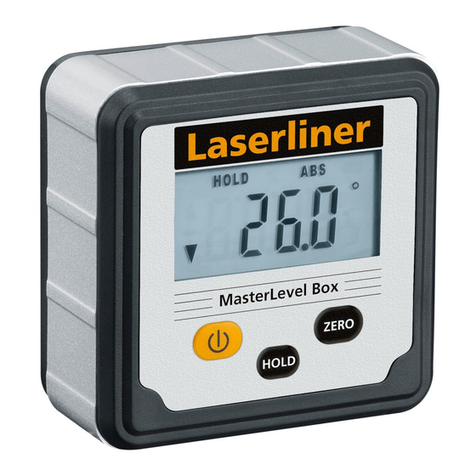Testomat EVO TH CAL User manual

1
Testomat® EVO TH CAL
Online analysis instrument
for residual total hardness
with calibration function
Operating Instructions

Content
2
Content
Content.................................................................................................2
Important safety information .............................................................5
Intended use....................................................................................5
Qualification of personnel ................................................................5
Warnings in this manual ..................................................................6
Additional documentation ................................................................6
Special attention is required at this point..............................................6
General Information.........................................................................6
Requirements for the installation site...............................................6
Requirements of cable for mains voltage and system components
and installed lines ............................................................................7
Requirements for cable ducts..........................................................7
During assembly..............................................................................8
During operation ..............................................................................8
During cleaning................................................................................9
Malfunctions/repairing a defective device........................................9
During disposal................................................................................9
Operating requirements.................................................................10
Delivery includes: .............................................................................11
Service description...........................................................................11
Available indicators for Testomat®EVO TH CAL devices..................12
Assembly...........................................................................................13
Assembling the Testomat®EVO TH CAL...........................................13
Use of the Testomat®EVO TH CAL within a pressure range of 0.3 to
1 bar....................................................................................................13
Connecting the water intake and discharge........................................14
Water intake...................................................................................14
Water drain ....................................................................................15
Connect mains and devices................................................................15
Block diagram of Testomat®EVO TH CAL....................................16
Internal structure of Testomat®EVO TH CAL.....................................17
Cable ducting.................................................................................18
Install power supply board and connect mains voltage.................18
Connect system components ........................................................19
Connect inputs and outputs...........................................................21
RS232 interface terminal assignment............................................22
Connect indicator bottle...................................................................23
Insert indicator bottle .....................................................................23
Open water intake..........................................................................23
Device settings and data input.......................................................24
Functions of the control and display elements .............................24
Switching the Testomat®EVO TH CAL device on/off....................24
Display functions............................................................................25
Control and function keys ..............................................................26
Operating system...........................................................................27
Control elements on the control board...........................................30
Mounting the SD card....................................................................30
Status displays of the SD card.......................................................30

Content
3
Getting started ..................................................................................31
Input basic programming data ........................................................32
Select operating mode........................................................................32
Select timing control.......................................................................32
Select quantity control ...................................................................32
Select quantity control/time priority................................................33
Configure interval (interval pause)......................................................33
Select indicator type and container size .............................................34
Calibration...........................................................................................34
Select measurement value unit...........................................................36
Limit value monitoring.........................................................................36
Input operating mode of LV1 and LV2 limit value outputs.............36
Switching functions of the LV1 and LV2 limit value outputs..........37
Input purge cycle.................................................................................39
Select water meter..............................................................................39
BOB operation (operation without constant supervision) ...................40
Description of the relay outputs ..........................................................41
LV1 and LV2 limit value outputs....................................................41
AUX (programmable functional output) .........................................42
Alarm (Fault signal output).............................................................42
Alarm/message –How to proceed when errors occur........................43
Water shortage ...................................................................................44
Error history.........................................................................................44
Description of the signal inputs/outputs..............................................45
Stop input.......................................................................................45
External delete (external acknowledge) ........................................46
Input water meter...........................................................................46
Current loop 0/4 - 20 mA.....................................................................46
Calculation of output currents........................................................47
Serial interface....................................................................................48
Notification format..........................................................................48
LCD settings........................................................................................49
Description of the SD card functions ..................................................49
Storing measurement values.........................................................50
Store error......................................................................................50
Interim storage for a non-inserted SD card ...................................51
Capacity of the SD card.................................................................51
Export basic programming data.....................................................51
Import basic programming data.....................................................52
Password protection ...........................................................................52
Password input ..............................................................................52
Change password..........................................................................53
Password protection ...........................................................................53
Firmware update.................................................................................53
Menu-driven firmware update........................................................53
Manual firmware update ................................................................55
Maintenance........................................................................................55
Configuring the maintenance interval............................................55
Acknowledge the maintenance......................................................55

Content
4
Information menu "i" ........................................................................56
Service menu.....................................................................................57
Structure of basic programming.....................................................59
Error messages/troubleshooting ....................................................60
Further possible errors........................................................................63
Error messages after self-test.............................................................63
Firmware update error list...................................................................65
Servicing and maintenance .............................................................68
Description of the maintenance work..................................................68
Replacing indicator ........................................................................68
Setting indicator fill level ................................................................69
Cleaning of the measuring chamber and the viewing windows.....69
Cleaning the filter housing .............................................................69
Care instructions.................................................................................70
Replacing the backup battery .............................................................70
Replacing fuses ..................................................................................71
Checklist Testomat®EVO TH CAL.....................................................75
Spare parts and accessories for Testomat®EVO TH CAL............77
Accessory............................................................................................78
Technical Data...................................................................................79
Equipment options ..............................................................................80
Declaration of conformity....................................................................81

Important safety information
5
Important safety information
Read the operating instructions carefully and in full before working
with the device.
Ensure that the operating instructions are accessible at any time for
all users. When an SD is used in the device, it can also be stored on
the same as a PDF file.
If transferring the Testomat®EVO TH CAL device to third parties,
ensure these operating instructions are always included.
Observe the safety precautions and safety recommendations when
using reagents, chemicals and cleaning agents. Observe the relevant
safety data sheet! For reagents we supply, the relevant safety data
sheets are available online at http://www.heyl.de.
Intended use
The scope of use of the Testomat®EVO TH CAL is the automatic
determination and monitoring of the residual total hardness (water
hardness) in water. In the process, the required measurement scope
is determined based on the selected indicator and corresponding
user programming.
Thanks to the additional calibration function, the Testomat®EVO TH
CAL can also be used where calibration of the measuring instrument
is important for controlling water quality, e. g. in the pharmaceutical
industry.
Comply with the output limits specified in the "Technical Data" sec-
tion.
Observe the areas/limits of application of the indicators and the re-
quirements imposed by the medium to be measured.
The scope of intended use presumes that you have read and under-
stood the instructions and particularly the section on "Important safety
information".
Improper use is deemed to occur if you use the device
outside the applicable scope, as specified in these instructions,
under operating conditions that deviate from the scope specified in
these instructions.
Qualification of personnel
The assembly and commissioning require basic electrical and pro-
cess engineering expertise as well as knowledge of the applicable
specialist terms. The assembly and commissioning must therefore be
performed only by a specialist or a properly trained person instructed
and supervised by a specialist.
A specialist is a person who can draw on professional training,
knowledge and experience as well as knowledge of applicable provi-
sions to assess work assigned to him/her, detect potential hazards

Important safety information
6
and implement suitable safety measures. A specialist must comply
with the applicable professional rules.
Warnings in this manual
These instructions include warnings against specified actions that
involve the risk of injury or property damage. Warnings are structured
as follows:
Description of the type or source of danger
Description of the consequences of non-compliance
Hazard prevention indications. Compliance with these hazard preven-
tion measures is imperative.
The signal word "RISK" refers to a significant danger that represents
a direct threat and will definitely result in severe injuries or even be
fatal if not avoided.
The signal word “WARNING" refers to a possible danger that may
result in severe injuries or even be fatal if not avoided.
The signal word "CAUTION" refers to a potentially dangerous situa-
tion that could result in minor to moderate injuries or property dam-
age if not avoided.
The signal word "NOTE" refers to important pieces of information. If
this information is not heeded, it may adversely affect operational
procedures.
Additional documentation
The Testomat®EVO TH CAL device is a system component. Accord-
ingly, you should also observe the Testomat®EVO TH CAL mainte-
nance manual and the system documentation of the system manu-
facturer.
Special attention is required at this point
General Information
During assembly and commissioning, observe the specific national
and local requirements.
Observe the accident prevention and conservation requirements in
the country of use and at the installation site.
Make no changes or modifications to the device that go beyond the
scope of use specified in these instructions. Doing so will void the
warranty.
Requirements for the installation site
Ensure that the following conditions are met at the installation site:
Use the device in indoor locations only.
The ambient temperature is between 10 and 40°C.
SIGNAL WORD!
WARNING
!
CAUTION
!
DANGER
!
NOTE
WARNING
!

Important safety information
7
The installation site is at altitudes under 2000 m.
The maximum relative humidity is 80% at temperatures of up to
31°C (linear declining up to 50% relative humidity at 40°C).
The device must always be protected against wetness and mois-
ture. Under no circumstances may it be exposed to splashed water
or condensate.
Surge category II
Soiling degree II
Requirements of cable for mains voltage and sys-
tem components and installed lines
Use only cables and installed lines which meet the following require-
ments:
Dielectric strength 30 V … 260 V according to the nominal voltage
(see specification plate)
The cable ducts installed by Gebr. Heyl in the device have a
clamping range of 4.5 mm –10 mm. This means that the external
diameter of the laid cable must remain within the range of 4.5 mm
–10 mm. If you use other ducts, the cable diameters must corre-
spond to the ducts.
The terminal strips on the circuit board require core cross-sections
of between 0.08 mm2and 2.5 mm2. This applies to single-wire and
fine-wire cores with wire end ferrules without plastic collar.
For fine-wire cores with wire end ferrules and plastic collar, the
cross-section may be up to 1.5 mm2.
For single-wire cores, AWG28 –AWG12 can also be used.
Optimum cross-section of the cores
If the core cross-section is less than 0.5 mm2, jamming may occur
when the cores are loosened from the terminal strip. We therefore
recommend using wires with cross-sections greater than 0.5 mm2.
Requirements for cable ducts
The recesses in the housing are intended for M16 ducts.
The ducts should have a smooth and rounded opening (to protect
against bending and abrasion).
Be careful to ensure securely fastened bending protection, which
must be five times the length of the maximum cable diameter.
The duct should include a strain relief that prevents slippage of the
cable and that cannot be disengaged without a tool.
You can order cable ducts from us as spare parts (Spare parts and
accessories).
If you use another cable duct, the material must have a flammabil-
ity rating of V1 or better.
NOTE

Important safety information
8
During assembly
Always disconnect the relevant system component from the power
source before assembling the device or connecting it to the power
supply or disconnecting it from the same. Prevent any inadvertent
reactivation of the device.
Only connect the device to the mains voltage as specified on the
type plate.
Observe the technical data and the environmental parameters.
The connections for mains voltage and relay outputs must be laid
separately from each other, to guarantee corresponding insulation
between the cables. Accordingly, do not operate the device if the
partition walls or terminal area covers are not present.
Avoiding interference voltages
The Testomat®EVO TH CAL device requires stable and uninterrupt-
ed supply voltage. Where applicable, use a mains filter to shield the
Testomat®EVO TH CAL device from interference voltages, which
may be generated for example within the network by magnetic valves
or large-scale engines. Never lay the connecting cables in parallel to
mains cables.
Handling may cause damage or destruction of electrical compo-
nents!
If you need to open the upper door, you should take the necessary
safety measures to avoid electrostatic discharge onto the compo-
nents (ESD safety).
Make sure you are earthed before opening the casing.
During operation
The device has no power switch.
Use an external power switch to turn the unit on and off. The
switch must be installed next to the device and must be marked as
power switch for the device - for example with a label.
Ensure that the maximum electrical load capacity of the switching
outputs is not exceeded, particularly for inductive loads. The power
supply for the user inclusive device is secured with a 4A fuse,
which means the total of all loads must not reach 4A.
In the event of any malfunctions, immediately switch off the Tes-
tomat®EVO TH CAL device and inform the service personnel.
Never attemt to repair the Testomat®EVO TH CAL device your-
self. Doing do will invalidate the guarantee. Repairs must be per-
formed by authorized service personnel only.
WARNING
!
NOTE
ATTENTION
!

Important safety information
9
During cleaning
Only use a dry and lint-free cloth.
Maintenance and care instructions are included in the section
"Servicing and maintenance” and in the Testomat®EVO TH CAL
maintenance manual
Malfunctions/repairing a defective device
A defective device, regardless of the guarantee period, can be
serviced only when the device is dismantled and the error is de-
scribed. Please also inform us of the indicator type currently in use
and the measured medium. Make no changes or modifications to
the device that go beyond the scope of use specified in these in-
structions. Doing so will void the warranty. This applies particularly
to the measuring chamber, the seal of which must remain undam-
aged. If you send the device in for repair, please completely empty
the measuring chamber and remove the indicator bottle and the
drain funnel. Also remove the power pack and send it back in the
original packaging.
Before dismantling, the type of error must be noted (error number,
error effect, log file of the SD card).
Once a protective device has been triggered (safety fuse), initially
try resolving the cause of error (e.g. by replacing a defective
valve), before reactivating the protective device. Frequent trigger-
ing always signifies an error, which under certain circumstances
may also damage the device.
Before sending the device in for maintenance or repair, pack-
age the power pack individually in the original box in which it
was delivered. If the original packaging is no longer available,
package the power pack to prevent breakage.
During disposal
Dispose of the device in accordance with the regulations of your
country.

Important safety information
10
Operating requirements
Problem-free operation of the Testomat®device is only possible
when using Heyl Testomat indicators and only within the pH range
of 4 –10.5! Using external indicators may invalidate the guarantee.
Only operate the device within the scope of parameters specified
under "Technical Data".
For Testomat®devices used to monitor water hardness, large
quantities of heavy metal ions in the hardened water may disturb
the color reaction, particularly
oIron over 0.5 mg/I
oCopper over 0.1 mg/I
oAluminum over 0.1 mg/l (brown-red color indication).
If the test water contains more than 20 mg/I CO2 (carbonic acid),
erroneous evaluations cannot be ruled out. In this case, use an ir-
rigator (e.g. optional accessory from Heyl Co.).
The water to be measured must be clean and free of bubbles!
The concentrations of disruptive ingredients can be determined
with colorimetric TESTOVAL® test comparators from Heyl Co.
In the event of
oexcessive carbonate hardness
othe presence of disinfecting agents
othe presence of silicate (used to protect pipes), the measur-
ing chamber may become soiled, which over time
may lead to erroneous evaluations
Careful handling of the device enhances the operational safety and
the service life! With this in mind, perform a visual inspection of the
device at regular intervals as follows:
oHas the expiry date of the indicator elapsed?
oAre the hose connections of the dosing pump leakproof?
oIs there any air in the dosing hoses?
oAre all water connections leakproof?
oIs the door of the device carefully closed?
oIs the device excessively soiled?
oAre the measuring chamber and drain channel/drain hose
clean?
Problem-free operation is contingent on regular maintenance!
Maintenance and care instructions can be found in the "Servicing
and maintenance" section.
Indications of problems can be found in the "Error messag-
es/troubleshooting" section.
CAUTION
!
NOTE

Delivery includes:
11
Delivery includes:
1 Testomat® EVO TH CAL
1 plastic bag with:
- Screw cap including hole and an insert for the screw cap of
the indicator bottle
1 package with:
- 1 plastic bag with
• Drain funnel
• 2 screws for mounting power supply unit
- Power supply
1 User manual
Attention!
Depending on your order, you may have a device with blue or black
housing. The operating instructions apply to both colours, as the
functionality is the same.
Service description
The scope of use of the Testomat®EVO TH CAL is the automatic
determination and monitoring of the residual total hardness (water
hardness) in water. In the process, the required measurement scope
is determined based on the selected indicator and corresponding
user programming.
Simplified menu-driven operation and programming via backlit
graphic LCD.
Based on the selected indicator, determinable measurement of
overall hardness (water hardness)
Free selection of hardness units in °dH, °f, ppm CaCO3, or mmol/l
Highly accurate measurement thanks to the use of precise piston-
dosing pump
Extended operating periods due to 500 ml indicator storage bottle
Analysis trigger:
–Automatic interval operation
(Interval pause can be configured from 0-99 minutes)
–Depending on quantity, via contact water meter
–External disruption of analysis
Two independent limit values with adjustable switching functions
as well as switching option in accordance with an adjustable num-
ber of negative analyses (Two neutral change-over contacts)
Logging on SD card for measurement data and notifications/alarms
with interim buffer for 100 measurement values and 50 notifica-
tions.
Import and Export of settings (basic program data) with selectable
filenames.
NOTE

Service description
12
Error history for 20 notifications
Firmware update via SD card
Built-in self-test with ongoing monitoring
Optional wireless retrieval of data with special WLAN SD card
Features for integration into process controllers:
–Fault signal output (neutral changeover contact) with Clear
input
–Current loop 0/4 - 20 mA for analog transfer of measurement
data
–Serial RS232 interface to transfer measurement data and no-
tifications/alarms
Available indicators for Testomat®EVO TH
CAL devices
Parameter/indicator type
Water hardness
TH 2005
TH 2025
TH 2100
TH 2250
Unit
°dH
(resolution)
0.05 - 0.50
(0.01)
0.25 - 2.50
(0.05)
1.0 - 10.0
(0.2)
2.5 - 25.0
(0.5)
°f
(resolution)
0.09 - 0.89
(0.02)
0.45 - 4.48
(0.1)
1.8 - 17.9
(0.4)
4.5 - 44.8
(1.0)
[ppm]
CaCO3
(resolution)
0.89 - 8.93
(0.2)
4.5 - 44.8
(0.9)
18 - 179
(3.8)
45 - 448
(10)
mmol/l
(resolution)
0.01 - 0.09
(0.01)
0.04 - 0.45
(0.01)
0.18 - 1.79
(0.04)
0.45 - 4.48
(0.1)
Please be careful to ensure that Heyl indicators are used!
Using external indicators may result in considerable measurement
deviations or measurement errors. Damage caused by foreign parti-
cles in the area of the dosing pump, measuring chamber or valves is
also possible. This may invalidate the guarantee!
At Heyl, we always strive to ensure the consistently high quality of
our indicators. They are specially tailored to the requirements of our
measuring devices and guarantee flawless measurement results.
NOTE

Assembly
13
Assembly
Hazard due to defective assembly!
Assemble the Testomat®EVO TH CAL device in a location shield-
ed from drips and splashes of water, dust and aggressive sub-
stances –e.g. in a switching cabinet or on a suitable wall.
Notes for problem-free operating procedures
Assemble the Testomat®EVO TH CAL device vertically and with-
out mechanical stresses.
Assemble the Testomat®EVO TH CAL device in a location free of
vibration.
Assembling the Testomat®EVO TH CAL
Requirements for the installation site
Select an installation site at which the length of the water inlet hose
can be minimized (max. 5 m)
Leave sufficient room on the left side of the device to open the
door.
Drill the mounting holes as specified in the accompanying sketch-
es.
Secure the device with three screws in a suitable place in the
switching cabinet or on the wall.
Use of the Testomat®EVO TH CAL within a
pressure range of 0.3 to 1 bar
Before assembling please check whether adaptation to a lower work-
ing pressure is required. When delivered, the device is equipped for a
pressure range of 1 to 8 bar. To operate the device within a pressure
range of 0.3 to 1 bar, the flow governor core should be removed
(e.g. when using a type R mini irrigator). For this purpose, take the
locking pin from the controller/filter housing . Then pull the con-
troller plug on the metal brackets out of the drill hole. Then remove
the flow governor core and re-insert the controller plug and locking
pin.
At pressures under 0.3 bar or when sucking out of a tank, our Me-
puClip booster pump can be used.
Remove for a
pressure
range of 0.3
to 1 bar
WARNING
!
NOTE
NOTE

Assembly
14
Connecting the water intake and discharge
When using a cooler
Water exceeding 40°C may lead to burns and may damage the
parts of the Testomat®EVO TH CAL exposed to the water.
Notes for problem-free operating procedures
The water pressure must be within the range 0.3 to 8 bar.
To operate within a pressure range of 0.3 to 1 bar or when supply-
ing via a booster pump, please remove the controller core from the
controller and filter housing. The pump should have a capacity of
25 to 35 liters/hour and be correspondingly resistant to the medium
being measured (e.g. our booster pump MepuClip Art. No. 270410)
For operation exceeding 8 bar, a pressure reducer must be used.
Significant pressure fluctuations should be avoided
The measurement water temperature must be between 10 and
40°C
For water temperatures exceeding 40°C, a cooler must be installed
in the intake of the Testomat®EVO TH CAL.
We recommend short intake lines (under 3m) to the Testomat®
EVO TH CAL. For intake lines longer than 3m, purge periods of
longer than 60s must be configured. For cable lengths exceeding 5
- 10m, we recommend external flushing via the AUX input.
Water intake
The test water is extracted from the sampling pipe and channeled to
the supply nozzles of the Testomat®EVO TH CAL. The device comes
with a plug connection for plastic hoses 6/4 x 1 as standard (external
diameter 6 mm/ internal diameter 4 mm, wall thickness 1 mm).
Connect the linking piece for the intake of the Testomat®EVO TH
CAL directly to the sampling pipe directly behind the water
treatment plant
Always establish the connection vertically upwards, to prevent dirt
particles from being conveyed from the sampling pipe to the device
Assemble a manual stop valve in the intake to the Testomat®EVO
TH CAL
For the water intake use opaque plastic pressure hose 6/4 x 1
(max. length 5 m)
Purge the intake to remove dirt particles
NO !!
"Sagging"
causes back-
water!
NOTE
CAUTION
!

Assembly
15
Water drain
The water is conveyed through the measuring chamber via an open
funnel and the drain hose installed on the same and into the duct.
Remove the supplied funnel and accommodate it underneath, in
the recess of the housing designated for that purpose.
Connect the funnel of the Testomat®EVO TH CAL with a drain
hose (internal diameter 12 mm/14 mm)
Lay this hose free of back pressure and without the siphon effect
to the drain
Connect mains and devices
Risk of injury from assembly when voltage present!
Unless you disconnect the power supply before commencing assem-
bly, you risk injury, destruction of the product or damage to system
components.
Disconnect all power to the relevant system component before
assembling the Testomat®EVO TH CAL device.
When connecting, use only verified cables with sufficient line
cross-section.
Disconnecting device for the power supply
The unit has no power switch!
Fit the Testomat®EVO TH CAL with a switch as a disconnecting
device for the power supply. Use an appliance switch or a circuit
breaker that meets the requirements of IEC 608947-1 and IEC
60947-3.
The switch must be within easy reach of the user of the Testomat®
EVO TH CAL and clearly marked as a disconnecting device for the
Testomat®EVO TH CAL.
For disconnection, you can also provide a three-pin plug near the
device, which is clearly marked as a disconnecting device for the
Testomat®EVO TH CAL.
Danger of damage due to electromagnetic fields!
If you assemble the Testomat®EVO TH CAL device or connecting
cables parallel to mains cables or in the vicinity of strong electro-
magnetic fields, the device may be damaged or the measurement
disrupted.
Keep the connecting cables as short as possible
Lay the connecting cables and mains cables separately.
Connect the device with the protective conductor (at 230/100-240
VAC).
Keep interference voltages away from the Testomat®EVO TH CAL
device –e.g. by using a mains filter.
WARNING
!
NOTE

Assembly
16
Shield the device from strong electromagnetic fields.
Block diagram of Testomat®EVO TH CAL
Illustrated position of relays: Device without current, mains: 230 V

Assembly
17
Internal structure of Testomat®EVO TH CAL
Terminal strip for inputs/outputs
Terminal strip for mains inlets and outlets
Terminal strip relay outputs
Dosing pump
Water connections, intake and outlet (funnel)
Controller/filter housing
Measuring chamber

Assembly
18
Cable ducting
To guarantee IP protection, the device is supplied with cable ductings
and blanking plugs. If you wish to use a relay output, you must re-
move the blanking plug from the cable ducting.
Proceed as follows in this instance:
Loosen the strain relief of the cable ducting (union nut).
Take out the blanking plug and insert the cable.
Tighten the union nut of the cable ducting and so establish the
strain relief.
Install power supply board and connect mains
voltage
Installing the terminal compartment cover
For technical safety reasons, the terminal compartment cover must
be put back in place immediately after connecting the mains voltage
and the system components, since the terminal space houses cables
that carry dangerous voltages. This helps prevent inadvertent contact
with the terminals and contact between the individual lines that may
carry different voltages and thus avoid the risk of a life-threatening
electric shock.
Also ensure that the cables are not pinched when installing the
terminal compartment cover!
Connect the device only to the mains voltage for which it is designed.
See type plate to confirm the suitable mains voltage. The installation
of the wide range power supply is identical to the installation of the
power supply board described here. To connect the cable, please
proceed as described below:
Remove both fixing screws and open the upper door.
Remove the power supply board from the box at the bottom of the
housing.
Insert the power supply board into the slot on the mainboard.
Screw in the two fastening screws at the top and bottom of the
mainboard.
Remove the fixing screws of the terminal cover and then remove
the terminal cover itself.
Lay the cable through the cable ducting provided for that pur-
pose.
Tighten the union nut of the cable ducting and so establish the
strain relief.
Connect the supply voltage to the terminals PE,N,L or, for 24 V
devices, to U and V terminals.
Ensure that the cores in the terminals are securely in place.
Install the terminal compartment cover.
DANGER
!
Observe ESD safety
precautions! See the
information on page 8

Assembly
19
Terminal designa-
tion
Type
Function
Note
Mass/PE
IN
Mains protective conductor
(5x)
Only for mains supply of
230 V and 100 –240V!
N (U)
L (V)
IN
Grid, N=Neutral conductor
(U=24V)
Grid, L=Phase (V=24V)
Power input 50-60 Hz
24 V / 100-240 V / 230 V
n
l
OUT
Neutral conductor, secured
with 4A (4x)
Phase, secured with 4A (4x)
Grid for consumers, max. 4
A
Connect system components
Take out the blanking plugs of the corresponding cable ductings.
Push through the cable of the component.
Tighten the union nut of the cable ducting and so establish the
strain relief.
Connect the system components to the output terminals of relays 1
to 4 (e.g. valves)
If the system components require mains power, connect the exter-
nal switched mains voltage (l) to the root contact of the respec-
tive relay (see accompanying connection example for 230 VAC)
Connect the neutral conductor of the system component with one
of the terminals (n)
For components with a protective conductor connection, connect
them to the PE connection.
Ensure that the cores in the terminals are securely in place
(Illustrated position of relays: Device without current, mains: 230 V)
Indicate external voltage on the relay contacts!
If you connect system components that do not operate using the de-
vice voltage, you can apply external voltages to the relay contacts.
This external voltage cannot be switched off via the external mains
switch.
There is a danger of electric shock!
Affix a warning to the device in this case (e.g. a sticker as shown left).
Connection example
Limit value contact LV 1
switches mains voltage
DANGER
!

Assembly
20
No.
Terminal
designation
Type
Function
Note
1
2
3
LV1
(limit value)
OUT
Limit value output 1 –root c
Limit value output 1 –closing contact
NO
Limit value output 1 –break contact NC
Floating relay output,
max. 240 VAC, 4 A
4
5
6
LV2
(limit value)
OUT
Limit value output 2 –root c
Limit value output 2 –closing contact
NO
Limit value output 2 –break contact NC
Floating relay output,
max. 240 VAC, 4 A
7
8
9
AUX
(auxiliaries)
OUT
Function output –root c
Function output –closing contact NO
Function output –break contact NC
Floating relay output,
max. 240 VAC, 4 A
10
11
12
Alarm
OUT
Fault signal output –root c
Fault signal output –closing contact NO
Fault signal output –break contact NC
Floating relay output,
max. 240 VAC, 4 A
Table of contents
Other Testomat Measuring Instrument manuals
Popular Measuring Instrument manuals by other brands
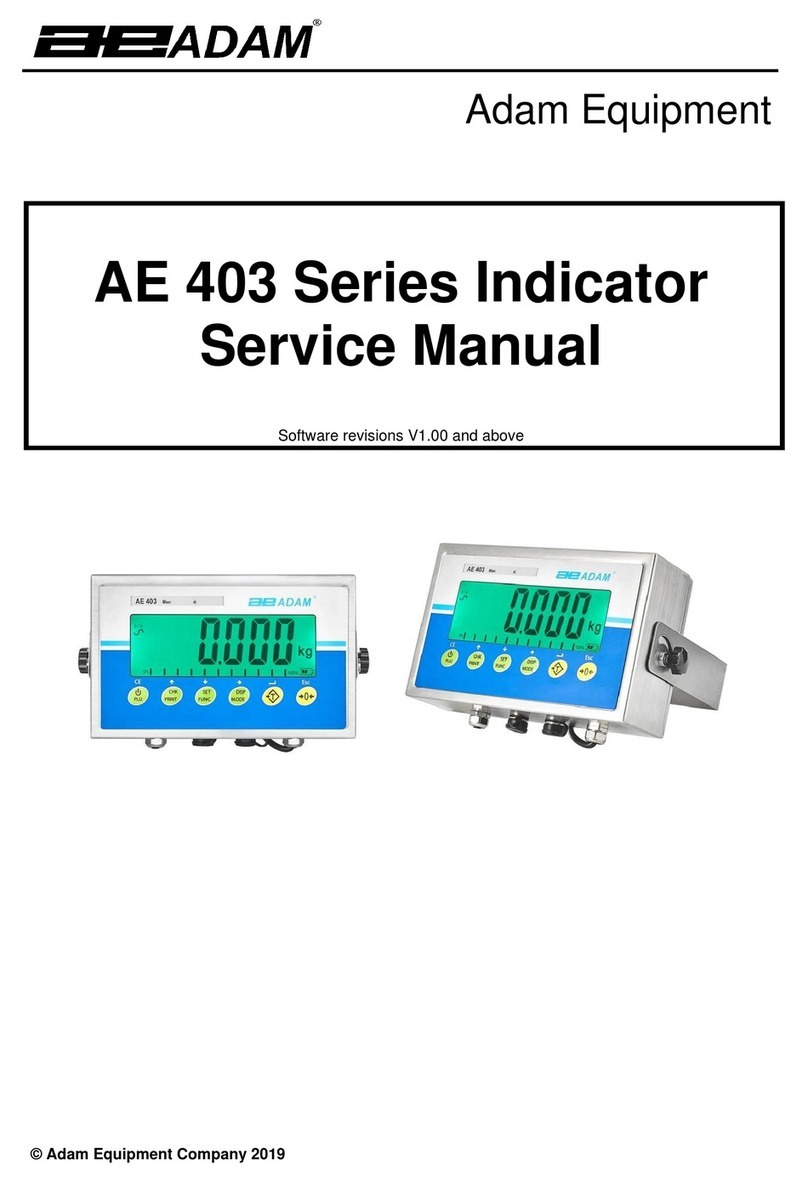
Adam Equipment
Adam Equipment AE 403 Series Service manual

SIGRIST
SIGRIST ScrubberGuard instruction manual
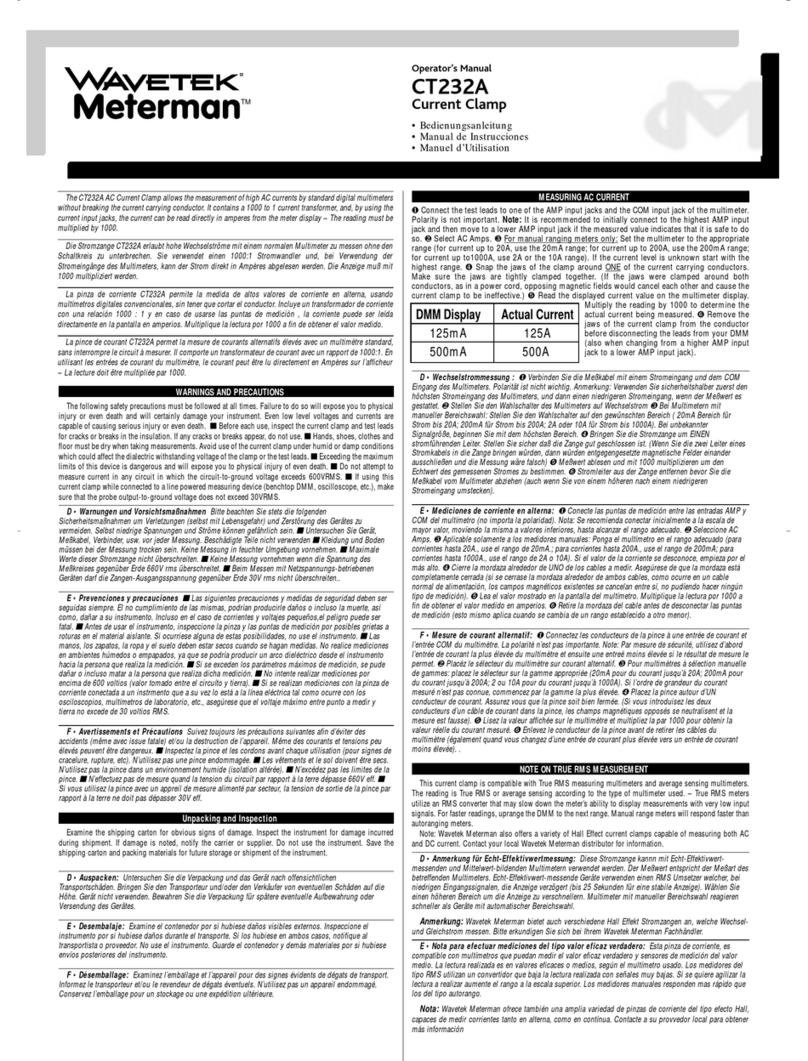
Wavetek
Wavetek CT232A Operator's manual
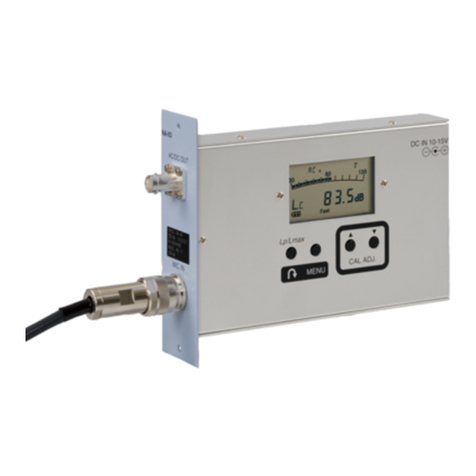
Rion
Rion NA-83 instruction manual
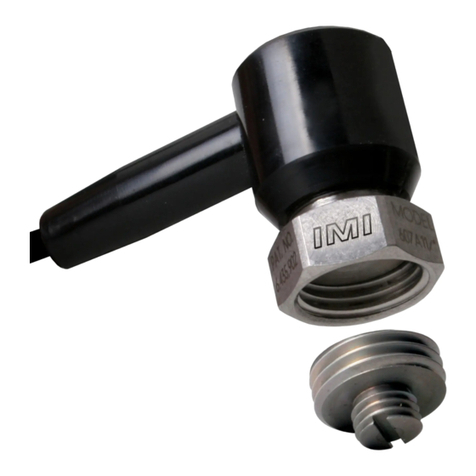
PCB Piezotronics
PCB Piezotronics IMI SENSORS TO607A11 Installation and operating manual
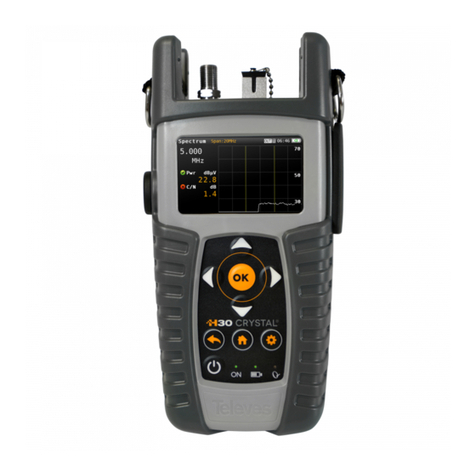
Televes
Televes H30 Evolution instruction manual




